Related Research Articles
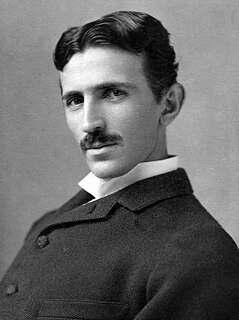
Nikola Tesla was a Serbian-American inventor, electrical engineer, mechanical engineer, and futurist best known for his contributions to the design of the modern alternating current (AC) electricity supply system.

Thomas Alva Edison was an American inventor and businessman. He developed many devices in fields such as electric power generation, mass communication, sound recording, and motion pictures. These inventions, which include the phonograph, the motion picture camera, and early versions of the electric light bulb, have had a widespread impact on the modern industrialized world. He was one of the first inventors to apply the principles of organized science and teamwork to the process of invention, working with many researchers and employees. He established the first industrial research laboratory.

An incandescent light bulb, incandescent lamp or incandescent light globe is an electric light with a wire filament heated until it glows. The filament is enclosed in a glass bulb with a vacuum or inert gas to protect the filament from oxidation. Current is supplied to the filament by terminals or wires embedded in the glass. A bulb socket provides mechanical support and electrical connections.
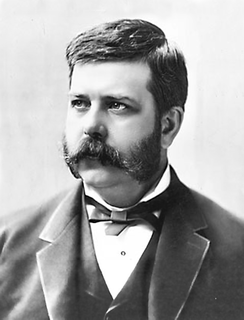
George Westinghouse Jr. was an American entrepreneur and engineer based in Pennsylvania who created the railway air brake and was a pioneer of the electrical industry, receiving his first patent at the age of 19. Westinghouse saw the potential of using alternating current for electric power distribution in the early 1880s and put all his resources into developing and marketing it. This put Westinghouse's business in direct competition with Thomas Edison, who marketed direct current for electric power distribution. In 1911 Westinghouse received the American Institute of Electrical Engineers's (AIEE) Edison Medal "For meritorious achievement in connection with the development of the alternating current system."

Artificial lighting technology began to be developed tens of thousands of years ago and continues to be refined in the present day.

An arc lamp or arc light is a lamp that produces light by an electric arc.

Henry Woodward was a Canadian inventor and a major pioneer in the development of the incandescent lamp. He was born in 1832.

Sir Joseph Wilson Swan FRS was an English physicist, chemist, and inventor. He is known as an independent early developer of a successful incandescent light bulb, and is the person responsible for developing and supplying the first incandescent lights used to illuminate homes and public buildings, including the Savoy Theatre, London, in 1881.
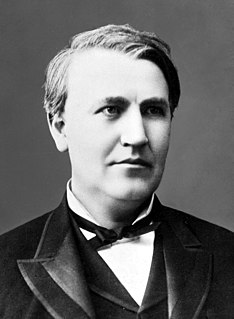
The war of the currents was a series of events surrounding the introduction of competing electric power transmission systems in the late 1880s and early 1890s. It grew out of two lighting systems developed in the late 1870s and early 1880s; arc lamp street lighting running on high-voltage alternating current (AC), and large-scale low-voltage direct current (DC) indoor incandescent lighting being marketed by Thomas Edison's company. In 1886, the Edison system was faced with new competition: an alternating current system developed by George Westinghouse's company that used transformers to step down from a high voltage so AC could be used for indoor lighting. Using high voltage allowed an AC system to transmit power over longer distances from more efficient large central generating stations. As the use of AC spread rapidly, the Edison Electric Light Company claimed in early 1888 that high voltages used in an alternating current system were hazardous, and that the design was inferior to, and infringed on the patents behind, their direct current system.

Heinrich Göbel, or Henry Goebel was a German-born American precision mechanic and inventor. In 1848 he emigrated to New York City, where he resided until his death. He received American citizenship in 1865.

Lewis Howard Latimer was a inventor and patent draftsman. His inventions included an evaporative air conditioner, an improved process for manufacturing carbon filaments for light bulbs, and an improved toilet system for railroad cars. In 1884, he joined the Edison Electric Light Company where he worked as a draftsman and wrote the first book on electric lighting. His house is located near the Latimer Projects and is a historic house located at 34-41 137th Street in Flushing, Queens, New York City.
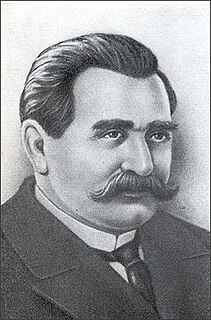
Alexander Nikolayevich Lodygin, known after immigration to US as Alexandre de Lodyguine was a Russian electrical engineer and inventor, one of the inventors of the incandescent light bulb.

Daniel McFarlan Moore was a U.S. electrical engineer and inventor. He developed a novel light source, the "Moore lamp", and a business that produced them in the early 1900s. The Moore lamp was the first commercially viable light-source based on gas discharges instead of incandescence; it was the predecessor to contemporary neon lighting and fluorescent lighting. In his later career Moore developed a miniature neon lamp that was extensively used in electronic displays, as well as vacuum tubes that were used in early television systems.
Tesla Electric Light and Manufacturing Company was an electric lighting company in Rahway, New Jersey that operated from December 1884 through 1886.

Francis Robbins Upton was an American physicist and mathematician. Upton worked alongside Thomas Edison in the development of incandescent light bulbs, electric generators, and electric power distribution. He was the first president of the Edison Pioneers.
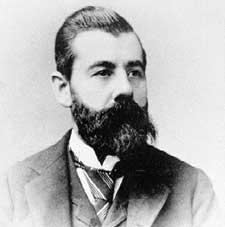
John Kruesi was a Swiss-born machinist, and close associate of Thomas Edison.

Willis Rodney Whitney was an American chemist and founder of the research laboratory of the General Electric Company. He is known as the "father of industrial research" in the United States for blending the worlds of research and industry together; which at the time, were two very distinct careers. He is also known for his corrosion theory of iron which he developed after studying at M.I.T. and the University of Leipzig. Whitney was also a professor at M.I.T. for some time before his career transition into research directing. He received many awards, including the Willard Gibbs medal, the Franklin medal, the Perkin medal, the Edison medal, the John Fritz medal, the Chandler medal, and many others. He was an astute believer in researching and experimenting for pleasure and voiced his belief at various science conferences.

Philip H. Diehl was a German-American mechanical engineer and inventor who held several U.S. patents, including electric incandescent lamps, electric motors for sewing machines and other uses, and ceiling fans. Diehl was a contemporary of Thomas Edison and his inventions caused Edison to reduce the price of his incandescent bulb.

John White Howell was an American electrical engineer who spent his entire professional career working for Thomas Edison, specializing in the development and manufacturing of the incandescent lamp.
Benjamin Electric Manufacturing Company was a Des Plaines, Illinois electrical company founded in the late 19th century.
References
Friedel, Robert, and Paul Israel. 1987. Edison's electric light: biography of an invention. New Brunswick, New Jersey: Rutgers University Press.
Hughes, Thomas P. 1977. Edison's method. In Technology at the Turning Point, edited by W. B. Pickett. San Francisco: San Francisco Press Inc., 5-22.
Hughes, Thomas P. 2004. American Genesis: A Century of Invention and Technological Enthusiasm 1870-1970. 2nd ed. Chicago: The University of Chicago Press.
Gorman, Michael E., and W. Bernard Carlson. 1990. Interpreting invention as a cognitive process : the case of Alexander Graham Bell, Thomas Edison and the telephone. Science, Technology and Human Values 15 (2):131-164.